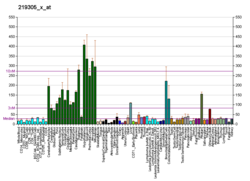| FBXO2 |
|---|
 |
| Available structures |
|---|
| PDB | Ortholog search: PDBe RCSB |
|---|
| List of PDB id codes |
|---|
1UMH, 1UMI, 2E31, 2E32, 2E33, 2RJ2 |
|
|
| Identifiers |
|---|
| Aliases | FBXO2, FBG1, FBX2, Fbs1, NFB42, OCP1, F-box protein 2 |
|---|
| External IDs | OMIM: 607112; MGI: 2446216; HomoloGene: 8132; GeneCards: FBXO2; OMA:FBXO2 - orthologs |
|---|
| Gene location (Human) |
|---|
 | | Chr. | Chromosome 1 (human)[1] |
|---|
| | Band | 1p36.22 | Start | 11,637,018 bp[1] |
|---|
| End | 11,655,785 bp[1] |
|---|
|
| Gene location (Mouse) |
|---|
 | | Chr. | Chromosome 4 (mouse)[2] |
|---|
| | Band | 4 E2|4 78.68 cM | Start | 148,245,078 bp[2] |
|---|
| End | 148,250,881 bp[2] |
|---|
|
| RNA expression pattern |
|---|
| Bgee | | Human | Mouse (ortholog) |
|---|
| Top expressed in | - amygdala
- C1 segment
- right frontal lobe
- anterior cingulate cortex
- caudate nucleus
- Brodmann area 9
- putamen
- nucleus accumbens
- right hemisphere of cerebellum
- prefrontal cortex
|
| | Top expressed in | - vestibular membrane of cochlear duct
- utricle
- vestibular sensory epithelium
- facial motor nucleus
- anterior horn of spinal cord
- optic nerve
- stria vascularis
- pontine nuclei
- medial vestibular nucleus
- cochlea
|
| | More reference expression data |
|
|---|
| BioGPS |  | | More reference expression data |
|
|---|
|
| Gene ontology |
|---|
| Molecular function | - amyloid-beta binding
- carbohydrate binding
- ubiquitin-protein transferase activity
- protein binding
- ubiquitin protein ligase activity
| | Cellular component | - organelle membrane
- membrane
- SCF ubiquitin ligase complex
- intracellular membrane-bounded organelle
- dendritic spine
- endoplasmic reticulum
- cytosol
- cytoplasm
| | Biological process | - ubiquitin-dependent protein catabolic process
- regulation of protein ubiquitination
- proteolysis
- SCF-dependent proteasomal ubiquitin-dependent protein catabolic process
- protein ubiquitination
- ubiquitin-dependent ERAD pathway
- glycoprotein catabolic process
- negative regulation of cell population proliferation
- protein polyubiquitination
- post-translational protein modification
| | Sources:Amigo / QuickGO |
|
| Orthologs |
|---|
| Species | Human | Mouse |
|---|
| Entrez | | |
|---|
| Ensembl | | |
|---|
| UniProt | | |
|---|
| RefSeq (mRNA) | | |
|---|
| RefSeq (protein) | | |
|---|
| Location (UCSC) | Chr 1: 11.64 – 11.66 Mb | Chr 4: 148.25 – 148.25 Mb |
|---|
| PubMed search | [3] | [4] |
|---|
|
| Wikidata |
| View/Edit Human | View/Edit Mouse |
|

 1umh: Structural basis of sugar-recognizing ubiquitin ligase
1umh: Structural basis of sugar-recognizing ubiquitin ligase

















